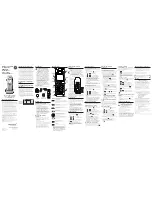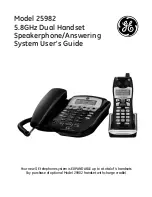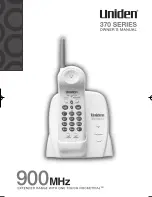
10
Government Statements
INDUSTRY CANADA CS03 STATEMENT
This product meets the applicable Industry Canada technical specifications.
This is confirmed by the registration number. The abbreviation, IC before the
registration number signifies that registration was performed based on a
Declaration of Conformity indicating that Industry Canada technical
specifications were met. It does not imply that Industry Canada approved
the equipment.
Before installing this equipment, users should ensure that it is permissable to
be connected to the facilities of the local telecommunications company. The
equipment must also be installed using an acceptable method of connec-
tions. The customer should be aware that compliance with the above condi-
tions may not prevent degradation of service in some situations.
Repairs to certified equipment shold be made by an authorized Canadian
maintenance facility designated by the supplier. Any repairs or alterations
made by the user of this equipment, or equipment malfunctions, may give the
telecommunications company cause to request the user to disconnect the
equipment.
WARNING!
Users should not attempt to make such connections themselves,
but should contact the appropriate electric inspection authority, or an
electrician, as appropriate.
CAUTION:
The Ringer Equivalence Number (REN) assigned to each
terminal device provides an indication of the maximum number of terminals
allowed to be connected to a telephone interface. The termication on an
interface may consist of any combination of devices subject only to the re-
quirement that the sum of the Ringer Equivalence Numbers of all the devices
does not exceed 5. An alternative indication of the REN is the Load Number
(LN). This number should be divided by 20 to approximate the equivalent
REN. The REN Number of this unit is indicated on the bottom of your an-
swering machine.
The FCC Wants You To Know
This equipment has been tested and found to comply with the limits for a
Class B digital device, pursuant to Part 15 of the FCC Rules. These limits are
designed to provide reasonable protection against harmful interference in a
residential installation.
This equipment generates, uses, and can radiate radio frequency energy and,
if not installed or used in accordance with the instructions, may cause harmful
interference to radio communications. However, there is no guarantee that
interference will not occur in a particular installation.
If this equipment does cause harmful interference to radio or television
reception, which can be determined by turning the equipment off and on, the
user is encouraged to try to correct the interference by one or more of the
following measures: 1) reorient or relocate the receiving antenna; 2) increase
the separation between the equipment and the receiver; 3) connect the
equipment to an outlet on a circuit different from that to which the receiver is
connected; 4) consult the dealer or an experienced radio/TV technician for
additional suggestions.
Any changes or modifications not expressly approved by the party respon-
sible for compliance could void the user’s authority to operate the equipment.
Where shielded interface cables have been provided with the product or speci-
fied additional components or accessories elsewhere defined to be used with
the installation of the product, they must be used in order to ensure compli-
ance with FCC regulation.
This device complies with Part 15 of the FCC Rules.
Operation is subject to the following two conditions:
(1) This device may not cause interference, and
(2) This device must accept any interference including interference that may
cause undesired operation of the device.
Canadian DOC Statement
DOC Class B Compliance -
This Class B digital apparatus complies with
Canadian ICES-003.






























